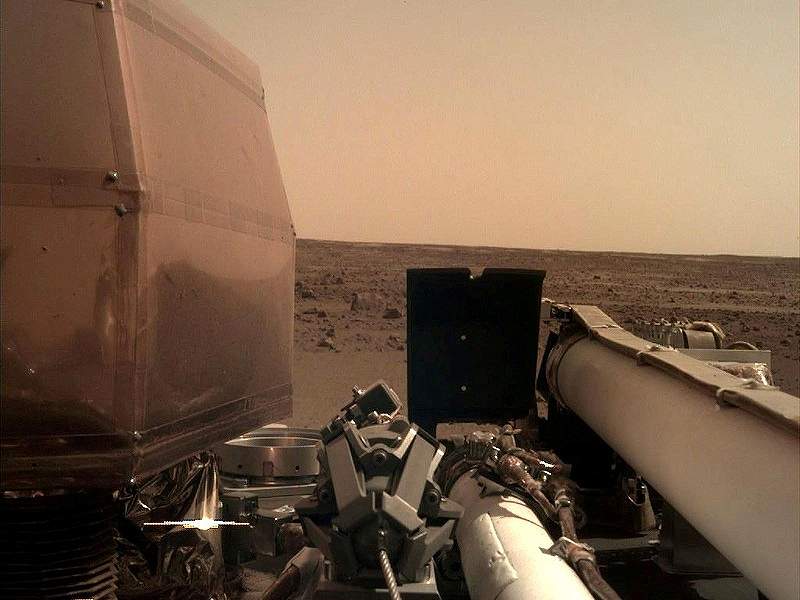
The Instrument Deployment Camera, located on the robotic arm of NASA’s InSight lander, took this image of the Martian surface on Nov. 26, 2018.
16:24 JST, December 28, 2022
LOS ANGELES (Reuters) — NASA has formally retired its Mars InSight lander, the first robotic probe specially designed to study the deep interior of a distant world, four years after it arrived on the surface of the red planet, the U.S. space agency announced on Dec. 21.
Mission controllers at NASA’s Jet Propulsion Laboratory (JPL) near Los Angeles determined the mission was over when two consecutive attempts to reestablish radio contact with the lander failed, a sign that InSight’s solar-powered batteries had run out of energy.
NASA predicted in late October that the spacecraft would reach the end of its operational life in a matter of weeks due to increasingly heavy accumulations of dust on its solar panels, depleting the ability of its batteries to recharge.
JPL engineers will continue to listen for a signal from the lander, just in case, but hearing from InSight again is unlikely, NASA said. The three-legged stationary probe last communicated with Earth on Dec. 15.
InSight landed on Mars in late November 2018 with instruments designed to detect planetary seismic rumblings never before measured anywhere but Earth, and its original two-year mission was later extended to four.
From its perch in a vast and relatively flat plain called Elysium Planitia just north of the planet’s equator, the lander has helped scientists gain new understanding of Mars’ internal structure.
Researchers said InSight’s data revealed the thickness of the planet’s outer crust, the size and density of its inner core and the structure of the mantle that lies in between.
One of InSight’s chief accomplishments was establishing that the red planet is, indeed, seismically active, recording more than 1,300 marsquakes. It also measured seismic waves generated by meteorite impacts.
“The seismic data alone from this discovery program mission offers tremendous insights not just into Mars but other rocky bodies, including Earth,” said Thomas Zurbuchen, associate administrator of NASA’s science mission directorate.
One such impact a year ago was found to have gouged boulder-sized chunks of water ice surprisingly close to Mars’ equator.
Even as InSight retires, a more recent robotic visitor to the red planet, NASA’s science rover Perseverance, continues to prepare a collection of Martian mineral samples for future analysis on Earth.
Last week, Perseverance deposited the first of 10 sample tubes it was directed to leave at a surface collection site on Mars as a backup cache, in case the primary supply stored in the rover’s belly cannot for some reason be transferred as planned to a retrieval spacecraft in the future, NASA said.
"Science & Nature" POPULAR ARTICLE
-

Genome Study Reveals Milestone in History of Cat Domestication
-

Big Leap in Quest to Get to Bottom of Climate Ice Mystery
-

Security Camera Footage Vulnerable to Outside Access; Investigation Finds 3,000 Pieces Exposed Online
-

Paws on Parade: Nairobi’s Dogs Dazzle at ‘Pawchella’
-

Japan Set to Participate in EU’s R&D Framework, Aims to Boost Cooperation in Tech, Energy
JN ACCESS RANKING
-

Keidanren Chairman Yoshinobu Tsutsui Visits Kashiwazaki-Kariwa Nuclear Power Plant; Inspects New Emergency Safety System
-

Tokyo Economic Security Forum to Hold Inaugural Meeting Amid Tense Global Environment
-

Imports of Rare Earths from China Facing Delays, May Be Caused by Deterioration of Japan-China Relations
-

University of Tokyo Professor Discusses Japanese Economic Security in Interview Ahead of Forum
-

Japan Pulls out of Vietnam Nuclear Project, Complicating Hanoi’s Power Plans






















